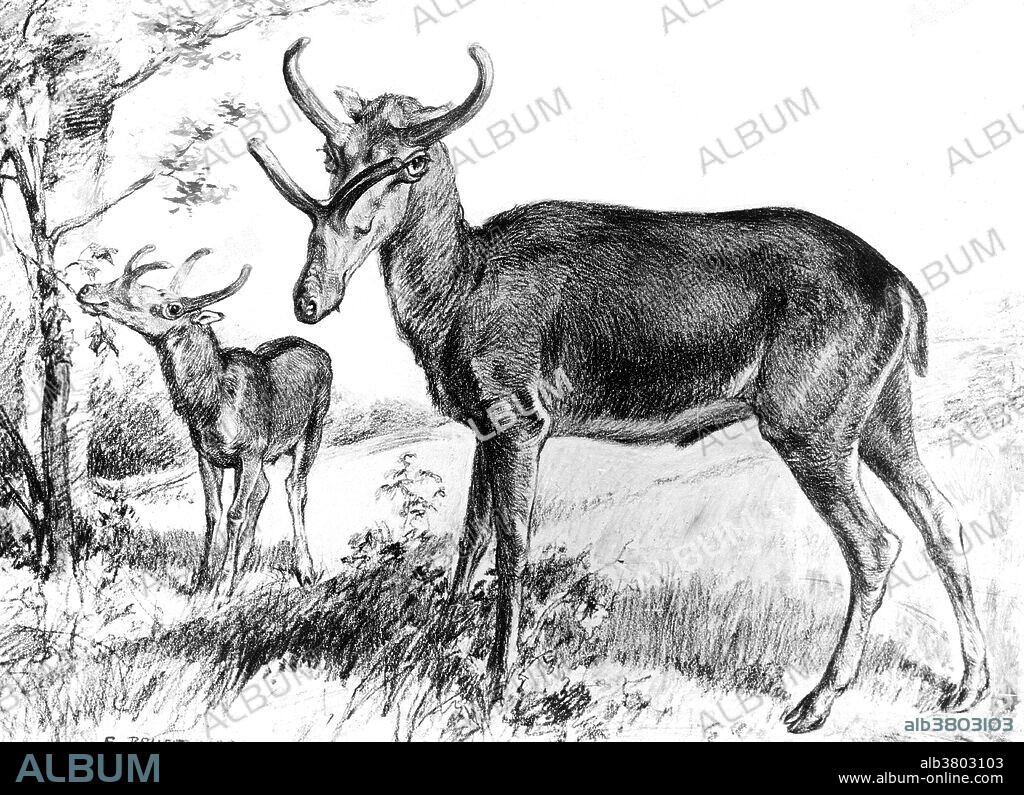alb3803103
Syndyoceras, Miocene Mammal

|
Add to another lightbox |
|
Add to another lightbox |



Buy this image.
Select the use:

Title:
Syndyoceras, Miocene Mammal
Caption:
Syndyoceras is a small extinct genus of Artiodactyla endemic to central North America from the Miocene epoch existing for approximately 4 million years. Although it looked like a modern deer, Syndyoceras was only a remote relative. This megafauna mammal was an even-toed ungulate, but it belonged to an obscure sub-family of this breed, the protoceratids, the only living descendants of which are camels. Syndyoceras males had a pair of large, sharp, cattle-like horns behind the eyes, and a smaller pair, in the shape of a V, on top of the snout. The horns also existed on females, but in much smaller proportions. They had large, tusk-like canine teeth, which it probably used while rooting for vegetation. Illustration originally captioned: A four horned Miocene deer, after Scott by Robert Bruce Horsfall. American Museum of Natural History. No date.
Category:
ILLUSTRATION • Historical & Fine Arts • Animals
Credit:
Album / USGS/Science Source
Releases:
Image size:
4800 x 3477 px | 47.7 MB
Print size:
40.6 x 29.4 cm | 16.0 x 11.6 in (300 dpi)
Keywords:
AGE • ÂGÉS • ANIMAL • ANIMALIA • ANIMALS • ART • ARTWORK • BW • CHORDATA • DRAWING • EPOCH • ERA • EXTINCT • EXTINCTION • FAUNA • HERBIVORE • HERBIVOROUS • HISTORIC • HISTORICAL & FINE ARTS • HISTORICAL • HISTORY • HOOFED ANIMAL = HOOVED ANIMAL • HOOFED ANIMAL • HOOVED ANIMAL • HORNED • ILLUSTRATION • ILLUSTRATIONS • ILUSTRATION • MAMMAL • MAMMALIA • MAMMALIAN • MAMMALS • MIOCENE DEER • MIOCENE ERA • MIOCENE PERIOD • MIOCENE TIME • MIOCENE • OLD • PALAEOBIOLOGY • PALAEONTOLOGY • PALAEOZOOLOGY • PALEOBIOLOGY • PALEONTOLOGY • PALEOZOOLOGY • PERIOD • PLANT EATER • PLANT EATING • PREHISTORIC • PREHISTORY • PRIMARY CONSUMERS • SYNDYOCERAS ARTIODACTYLA • TERRESTRIAL VERTEBRATE • TIME • UNGULATE • VERTEBRATE • WILDLIFE
 Pinterest
Pinterest Twitter
Twitter Facebook
Facebook Copy link
Copy link Email
Email
